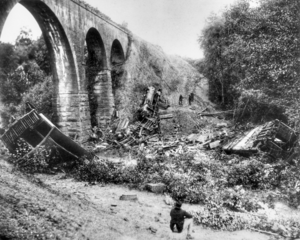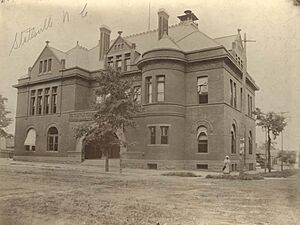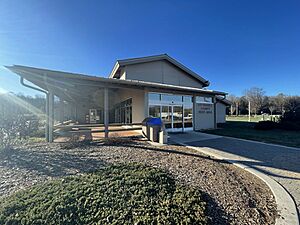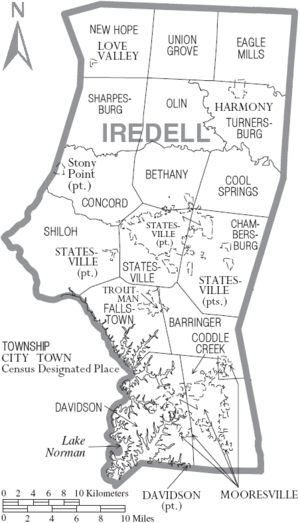Iredell County, North Carolina facts for kids
Quick facts for kids
Iredell County
|
|||
|---|---|---|---|
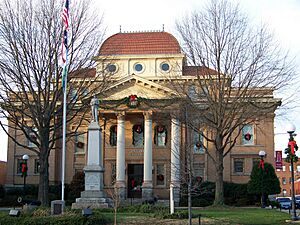
Iredell County Courthouse and Confederate Monument in Statesville
|
|||
|
|||
| Motto(s):
"Crossroads for the Future"
|
|||
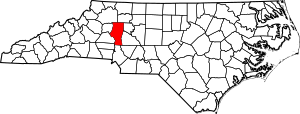
Location within the U.S. state of North Carolina
|
|||
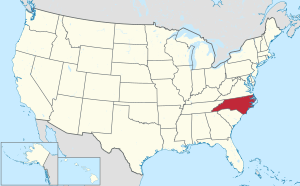 North Carolina's location within the U.S. |
|||
| Country | |||
| State | |||
| Founded | 1788 | ||
| Named for | James Iredell | ||
| Seat | Statesville | ||
| Largest community | Mooresville | ||
| Area | |||
| • Total | 597.39 sq mi (1,547.2 km2) | ||
| • Land | 574.41 sq mi (1,487.7 km2) | ||
| • Water | 22.98 sq mi (59.5 km2) 3.85% | ||
| Population
(2020)
|
|||
| • Total | 186,693 | ||
| • Estimate
(2023)
|
199,710 | ||
| • Density | 325.02/sq mi (125.49/km2) | ||
| Time zone | UTC−5 (Eastern) | ||
| • Summer (DST) | UTC−4 (EDT) | ||
| Congressional district | 10th | ||
Iredell County is a county located in the U.S. state of North Carolina. As of the 2020 census, about 186,693 people lived there. Its main town, called the county seat, is Statesville. The biggest community is Mooresville.
Iredell County was created in 1788 from a part of Rowan County. It is named after James Iredell, who was one of the first judges on the Supreme Court. Iredell County is part of the larger Charlotte metropolitan area, which includes cities like Charlotte and Concord.
Contents
History of Iredell County
Before European settlers arrived, the area that is now Iredell County was likely home to several Native American tribes. These tribes, like the Catawba and Wateree, spoke a language called Siouan.
Here are some important events in the history of Iredell County:
- 1730s-1750s: The first European settlers, mostly from Scotland, Ireland, and Germany, moved into the area. They were looking for good land, game, and fresh water.
- 1753: Rowan County was created from a part of Anson County. Iredell County would later be formed from Rowan County.
- 1754-1763: Fort Dobbs was built to protect settlers during the French and Indian War. Today, you can visit Fort Dobbs as a North Carolina State Historic Site.
- 1775-1783: During the American Revolutionary War, many local residents served in the North Carolina Militia.
- 1788: Iredell County was officially formed. It was named after James Iredell, who was an important lawyer and judge. Statesville was chosen as the county seat.
- 1847: A part of Iredell County was used to create Alexander County.
- 1858: The Western North Carolina Railroad arrived, which helped the county grow.
- 1861-1865: The American Civil War took place.
- 1891: A train accident on the Bostian Bridge near Statesville killed 23 people.
- Early 1900s: Industries like tobacco, liquor, and herbs were important. Later, farming of livestock, dairy products, and chickens became very important.
- 1924: The first Ole Time Fiddlers' Convention was held in Union Grove.
- 1954: The unique cowboy town of Love Valley was created by Jeter Andrew Barker.
- The North Carolina Auto Racing Hall of Fame is located in Mooresville, which is known as "Race City USA."
Geography and Nature
Iredell County covers about 597 square miles. Most of this is land, with about 23 square miles being water.
The county is in the Piedmont Region of North Carolina. The northwestern part has the Brushy Mountains. These are smaller mountains that stand out from the land around them. The highest point in Iredell County is Fox Mountain, which is 1,760 feet tall. The rest of the county has gently rolling hills and small river valleys.
The Catawba River forms much of the county's western border. Lake Norman, the largest man-made lake in North Carolina, is a big feature in southern Iredell County. People sometimes call it North Carolina's "inland sea."
Transportation and Roads
Iredell County is a key transportation spot because Interstate 77 and Interstate 40 cross paths in Statesville. This is why the county's slogan is "Crossroads for the Future." These highways make it easy to travel to cities like Charlotte, Winston-Salem, Greensboro, Raleigh, and Asheville.
The northern part of Iredell County is mostly rural, meaning it has a lot of open land and not many big towns. Because of this, the speed limit on Interstate 77 north of Statesville is 70 miles per hour.
Iredell County is one of the longest counties in North Carolina, stretching almost 50 miles from north to south.
Protected Areas and Sites
Major Water Bodies
- Catawba River
- Lake Norman
- Lookout Shoals Lake
- Rocky River
- South Yadkin River
- Third Creek
Neighboring Counties
- Yadkin County – north
- Davie County – east
- Rowan County – east
- Cabarrus County – southeast
- Mecklenburg County – south
- Lincoln County – southwest
- Catawba County – southwest
- Alexander County – west
- Wilkes County – north
Main Highways
 I-40
I-40 I-77
I-77 US 21
US 21 US 64
US 64 US 70
US 70 NC 3
NC 3 NC 90
NC 90 NC 115
NC 115 NC 150
NC 150 NC 152
NC 152 NC 801
NC 801 NC 901
NC 901
Important Transportation Hubs
- City of Statesville Regional Airport
- Davis Regional Heliport, near Statesville
- Iredell County has two railroads: Alexander Railroad and Norfolk Southern Railway
- Lake Norman Airpark, near Mooresville
Population and People
| Historical population | |||
|---|---|---|---|
| Census | Pop. | %± | |
| 1790 | 5,430 | — | |
| 1800 | 8,856 | 63.1% | |
| 1810 | 10,972 | 23.9% | |
| 1820 | 13,071 | 19.1% | |
| 1830 | 14,918 | 14.1% | |
| 1840 | 15,685 | 5.1% | |
| 1850 | 14,719 | −6.2% | |
| 1860 | 15,347 | 4.3% | |
| 1870 | 16,931 | 10.3% | |
| 1880 | 22,675 | 33.9% | |
| 1890 | 25,462 | 12.3% | |
| 1900 | 29,064 | 14.1% | |
| 1910 | 34,315 | 18.1% | |
| 1920 | 37,956 | 10.6% | |
| 1930 | 46,693 | 23.0% | |
| 1940 | 50,424 | 8.0% | |
| 1950 | 56,303 | 11.7% | |
| 1960 | 62,526 | 11.1% | |
| 1970 | 72,197 | 15.5% | |
| 1980 | 82,538 | 14.3% | |
| 1990 | 92,931 | 12.6% | |
| 2000 | 122,660 | 32.0% | |
| 2010 | 159,437 | 30.0% | |
| 2020 | 186,693 | 17.1% | |
| 2023 (est.) | 199,710 | 25.3% | |
| U.S. Decennial Census 1790–1960 1810{–1850 1900–1990 1990–2000 2010 2020 |
|||
2020 Census Information
| Race | Number | Percentage |
|---|---|---|
| White (non-Hispanic) | 136,393 | 73.06% |
| Black or African American (non-Hispanic) | 21,255 | 11.39% |
| Native American | 437 | 0.23% |
| Asian | 4,718 | 2.53% |
| Pacific Islander | 58 | 0.03% |
| Other/Mixed | 8,055 | 4.31% |
| Hispanic or Latino | 15,777 | 8.45% |
As of the 2020 census, there were 186,693 people living in Iredell County. This included 68,145 households and 49,635 families.
Past Census Information
In 2010, there were 159,437 people. The county's population density was about 277 people per square mile. The population was made up of different groups, including White, Black or African American, Native American, Asian, and Hispanic or Latino people.
In 2000, about 33.5% of households had children under 18 living with them. The average household had 2.56 people. The median age in the county was 36 years old.
Economy and Jobs
Farming is still a big part of the economy in Iredell County. Dairy farming has been popular for a long time. However, as more people move to southern Iredell County, some farms are being replaced by shopping centers and new neighborhoods.
Iredell County is a major center for NASCAR racing. Many race shops are located here, especially around Mooresville. The NASCAR Technical Institute trains students for jobs in the racing industry. Many NASCAR drivers also live near Mooresville and Lake Norman.
While northern Iredell County remains mostly rural, the southern part is growing quickly. This is because the Lake Norman area is very popular for people who work in nearby Charlotte, North Carolina's largest city.
Lowe's, a large home improvement company, has its main office in Mooresville.
Education in Iredell County
The county has two main public school districts: Iredell-Statesville Schools (ISS) and Mooresville Graded School District (MGSD). There are also several public charter schools.
Iredell-Statesville School District
This district includes many schools, from elementary to high school. Some high schools are:
- Lake Norman High School
- North Iredell High School
- South Iredell High School
- Statesville Senior High School
- West Iredell High School
Mooresville Graded School District
This district also has schools for all ages. Some high schools are:
- Mooresville Senior High
Public Charter Schools
- Pine Lake Preparatory
- Langtree Charter Academy
- American Renaissance School
- Iredell Charter Academy
Private Schools
- Statesville Christian School
- Woodlawn School
Colleges and Universities
Mitchell Community College in Statesville was first founded in 1856 as Concord Female College. It changed its name to Mitchell College in 1917.
Communities in Iredell County
Cities and Towns
- Statesville (the county seat)
- Davidson (mostly in Mecklenburg County)
- Harmony
- Love Valley (a small part is in Alexander County)
- Mooresville (the largest community)
- Troutman
Census-Designated Places
These are areas that are like towns but are not officially incorporated.
- Lake Norman of Iredell
- Stony Point (also partly in Alexander County)
Unincorporated Communities
These are smaller communities that are not part of any city or town.
Townships
In 1868, Iredell County was divided into townships. Before that, areas were called "Captain's Districts."
- Barringer
- Bethany
- Chambersburg
- Coddle Creek
- Concord
- Cool Springs
- Davidson
- Eagle Mills
- Fallstown
- New Hope
- Olin
- Sharpesburg
- Shiloh
- Statesville
- Turnersburg
- Union Grove
Notable People from Iredell County
Many interesting people have connections to Iredell County:
- Jeter Andrew Barke, Jr. (1924–2011) – He was a military veteran, builder, and the founder of the town of Love Valley.
- Hutchins Gordon Burton (born after 1774–1836) – He was the 22nd governor of North Carolina.
- Bobby Dale Earnhardt (born 1987) – A NASCAR racing driver.
- James Hall, D.D. (1744–1826) – A Presbyterian minister.
- James Iredell, Sr. (1750–1799) – The county is named after him. He was an important judge.
- Homer Maxwell Keever (1905–1979) – A local teacher, historian, and author.
- Anderson Mitchell (1800–1876) – A U.S. congressman from North Carolina.
- William Sharpe (1742–1818) – A patriot during the American Revolutionary War and a lawyer.
- Wilfred D. Turner (1855–1933) – The 9th lieutenant governor of North Carolina.
- Zebulon Baird Vance (1830–1894) – He was the 37th and 43rd governor of North Carolina. He lived in Statesville, and his home is now a museum.
Images for kids
See also
 In Spanish: Condado de Iredell para niños
In Spanish: Condado de Iredell para niños





